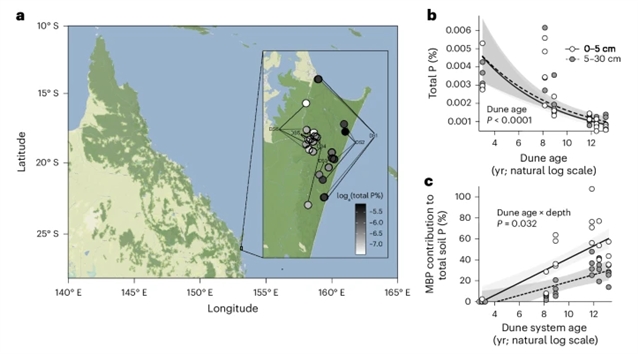
近日,澳大利亚格里菲斯大学O. M. Butler团队揭示了微生物生理学在长期生态系统发展中保护磷。这一研究成果发表在2025年5月12日出版的《自然—地球科学》杂志上。
长期陆地生态系统发展的特点是土壤磷(P)下降,生物磷限制相应增加。磷限制生态系统的功能依赖于土壤微生物对磷的有效利用,但微生物在生态系统发育过程中管理磷缺乏的生理策略尚不清楚。
通过将土壤代谢组学技术的最新进展应用于从澳大利亚东部约70万年的生态系统发展时间序列中收集的样本,研究组表明,土壤微生物的磷效率生理策略包括高比例的非磷膜脂质以及大量的细胞内碳储存。
这些策略在初级演替期间增殖,并在退化、缺磷的生态系统中达到最大化,维护了微生物碳限制、三重建模的磷矿化潜力,可以保存植被地上生物量中近两倍的磷。这些发现通过揭示土壤微生物的生态生理学与生态系统发展的长期轨迹之间强烈但被忽视的相互作用,改变了人们对陆地生态系统的理解。
附:英文原文
Title: Microbial physiology conserves phosphorus across long-term ecosystem development
Author: Butler, O. M., Manzoni, S., Liang, G., Matsumura, S., Warren, C. R.
Issue&Volume: 2025-05-12
Abstract: Long-term terrestrial ecosystem development is characterized by declining soil phosphorus (P) and a corresponding increase in biological P limitation. The function of P-limited ecosystems relies on efficient use of P by soil microorganisms, but the physiological strategies used by microorganisms to manage P scarcity during ecosystem development are unknown. Here, by applying recent advances in soil metabolomic techniques to samples collected from a ~700,000-year chronosequence of ecosystem development in eastern Australia, we show that soil microbial physiological strategies for P efficiency include a high proportion of non-phosphorous membrane lipids along with substantial intracellular carbon storage. These strategies—which proliferate during primary succession and are maximized in retrogressive, P-depleted ecosystems—uphold microbial carbon limitation, triple modelled P-mineralization potential and can conserve close to double the P contained in the aboveground biomass of vegetation. These findings transform our understanding of terrestrial ecosystems by revealing a strong yet overlooked interplay between the ecophysiology of soil microorganisms and the long-term trajectory of ecosystem development.
DOI: 10.1038/s41561-025-01696-2
Source: https://www.nature.com/articles/s41561-025-01696-2
